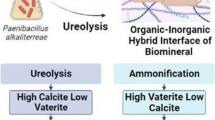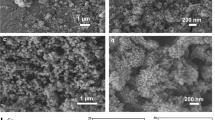Abstract
Fresh Geobacillus thermoglucosidasius cells grown on soybean-casein digest nutrient agar were inoculated as a parent colony 1 cm in diameter on the surface of an agar gel containing acetate and calcium ions (calcite-promoting hydrogel) and incubated at 60 °C for 4 days, after which magnesium-calcite single crystals of 50–130 µm in size formed within the parent colony. Addition of EDTA, polyacrylic acid or N,N-dicyclohexylcarbodiimide to the calcite-forming hydrogel inhibited the parent colony from forming magnesium-calcite crystals. Inoculation of G. thermoglucosidasius on calcite-forming hydrogel containing 5 µM cadmium and 20 µM zinc resulted in a decrease in the sporulation rate from 55 to 7–8 %. Magnesium-calcite synthesis decreased relative to the sporulation rate. G. thermoglucosidasius exhibited higher adsorption/absorbance of calcium than other Geobacillus sp. that do not mediate calcite formation and higher levels of magnesium accumulation. Calcium ions contained in the calcite-promoting hydrogel and magnesium ions concentrated in G. thermoglucosidasius cells serve as the elements for magnesium-calcite synthesis. The observed decreases in sporulation rate and magnesium-calcite formation support the hypothesis that endospores act as nuclei for the synthesis of magnesium-calcite single crystals.





Similar content being viewed by others
References
Amor M, Busigny V, Durand-Dubief M, Tharaud M, Ona-Nguema G, Gélabert A, Guyot F (2015) Chemical signature of magnetotactic bacteria. Proc Natl Acad Sci USA 112:1699–1703
Beck L, Jahns T (1996) Regulation of leucine transport by intracellular pH in Bacillus pasteurii. Arch Microbiol 165:265–271
Blakemore R (1975) Magnetotactic bacteria. Science 190:377–379
Boquet E, Boronat A, Ramos-Cormenzana A (1973) Production of calcite (calcium carbonate) crystals by soil bacteria is a general phenomenon. Nature 246:527–529
Bornside GH, Kallio RE (1956) Urea-hydrolyzing bacilli II.: nutritional profiles. J Bacteriol 71:655–660
Chung JK, Yoon HE, Shin HC, Choi EY, Byeon WH (2009) Induction of growth phase-specific autolysis in Bacillus subtilis 168 by growth inhibitors. J Microbiol 47:50–59
Gadd GM (2010) Metals, minerals and microbes: geomicrobiology and bioremediation. Microbiology 156:609–643
Hamilton WA (2003) Microbially influenced corrosion as a model system for the study of metal–microbe interactions: a unifying electron transfer hypothesis. Biofouling 19:65–76
He L, Xue R, Song R (2009) Formation of calcium carbonate films on chitosan substrates in the presence of polyacrylic acid. J Solid State Chem 182:1082–1087
He S, Guo Z, Zhang Y, Zhang S, Wang J, Gu N (2007) Biosynthesis of gold nanoparticles using the bacteria Rhodopseudomonas capsulata. Mater Lett 61:3984–3987
Hogarth C, Ellar DJ (1978) Calcium accumulation during sporulation of Bacillus megaterium KM. Biochem J 176:197–203
Hogarth C, Ellar DJ (1979) Energy-dependence of calcium accumulation during sporulation of Bacillus megaterium KM. Biochem J 178:627–632
Kandori K, Horigami N, Yasukawa A, Ishikawa T (1997) Texture and formation mechanism of fibrous calcium hydroxyapatite particles prepared by decomposition of calcium–EDTA chelates. J Am Ceram Soc 80:1157–1164
Lacriola CJ, Falk SP, Weisblum B (2013) Screen for agents that induce autolysis in Bacillus subtilis. Antimicrob Agents Chemo 57:229–234
Meier KJS, Berger C, Kinkel H (2014) Increasing coccolith calcification during CO2 rise of the penultimate deglaciation (Termination II). Mar Micropaleontol 112:1–12
Murai R, Yoshida N (2013) Geobacillus thermoglucosidasius endospores function as nuclei for the formation of single calcite crystals. Appl Environ Microbiol 79:3085–3090
Nakatani Y, Imagawa M, Nishihara T, Kondo M (1985) Inhibition of cortex hydrolysis during spore germination by CdCl2. Microbiol Immunol 29:119–126
Narayanan KB, Sakthivel N (2010) Biological synthesis of metal nanoparticles by microbes. Adv Colloid Interface Sci 156:1–13
Ohse M, Takahashi K, Kadowaki Y, Kusaoke H (1995) Effects of plasmid DNA sizes and several other factors on transformation of Bacillus subtilis ISW1214 with plasmid DNA by electroporation. Biosci Biotechnol Biochem 59:1433–1437
Paasche E (2001) A review of the coccolithophorid Emiliania huxleyi (Prymnesiophyceae), with particular reference to growth, coccolith formation, and calcification-photosynthesis interactions. Phycologia 40:503–529
Raeymaekers L, Wuytack EY, Willems I, Michiels CW, Wuytack F (2002) Expression of a P-type Ca2+-transport ATPase in Bacillus subtilis during sporulation. Cell Calcium 32:93–103
Raut SH, Sarode DD, Lele SS (2014) Biocalcification using B. pasteurii for strengthening brick masonry civil engineering structures. World J Microbiol Biotechnol 30:191–200
Rothenstein D, Baier J, Schreiber TD, Barucha V, Bill J (2012) Influence of zinc on the calcium carbonate biomineralization of Halomonas halophila. Aqua Biosys 8:31. doi:10.1186/2046-9063-8-31
Stähl S (1978) Calcium uptake and survival of Bacillus stearothermophilus. Arch Microbiol 119:17–24
Stocks-Fischer S, Galinat JK, Bang SS (1999) Microbiological precipitation of CaCO3. Soil Biol Biochem 31:1563–1571
Tanaka S, Tsumura S, Yoshida N (2005) JP Patent 2005-168302
Wakeman CA, Goodson JR, Zacharia VM, Winkler WC (2014) Assessment of the requirements for magnesium transporters in Bacillus subtilis. J Bacteriol 196:1206–1214
Yoshida N, Higashimura E, Saeki Y (2010) Catalytic biomineralization of fluorescent calcite by the thermophilic bacterium Geobacillus thermoglucosidasius. Appl Environ Microbiol 76:7322–7327
Author information
Authors and Affiliations
Corresponding author
Ethics declarations
Conflict of Interest
We declare that we have no conflict of interest.
Rights and permissions
About this article
Cite this article
Murai, R., Yoshida, N. Magnesium-Calcite Crystal Formation Mediated by the Thermophilic Bacterium Geobacillus thermoglucosidasius Requires Calcium and Endospores. Curr Microbiol 73, 696–703 (2016). https://doi.org/10.1007/s00284-016-1115-8
Received:
Accepted:
Published:
Issue Date:
DOI: https://doi.org/10.1007/s00284-016-1115-8




